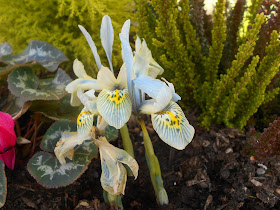Accordingly I set out to visit Stefen Hill Pocket Park but, although the morning was producing sunny spells, I was not optimistic. Coltsfoot, Tussilago farfara, was flowering but its heart clearly wasn't in it; was growing in a shady spot and had clearly decided to wait for warmer or sunnier conditions before fully opening. Apparently one old name was coughwort, the leaves having once been used as a herbal tobacco. During the Second World War coltsfoot rock was sold and, because it was regarded as a medicine, was not subject to sweet rationing (quoted by Richard Mabey, Ref. 2)
 |
Coltsfoot had not fully opened but, with no insects about, what would
be the point? Stefen Hill Pocket Park, 27 February, 2020
|
Many flowering plants eschew clay but coltsfoot seems perfectly happy on this generally intractable material and often forms large colonies on it. The silky pappus on the fruit (and the felty layer on the underside of the leaves) has been put to various uses in the past, including tinder - "rapped in a rag and boiled in a little lee with salt-petre added." (Ref 1). Goldfinches will use the pappus to line their nests.
I carefully made my way over very squelchy ground to the one and only pond and was delighted to see it holding huge quantities of frogspawn.
 |
The water may be chilly but the local frogs had been busy.
Stefen Hill Pocket Park, 27 February, 2020
|
No frogs were to be seen but having spawned I suppose they saw no reason to hang around.
 |
| It is not unusual for the spawn to break the surface. |
Still treading warily I moved on to a group of ash trees 100 metres away. I had noticed on earlier visits that the (three) trunks of one specimen bore rather peculiar lesions. Once home I did a spot of research and found that they were caused by Pseudomonas syringae (it has other synonyms).
 |
Pseudomonas syringae has caused the development of these odd-looking
burrs. Stefen Hill Pocket Park, 27 February, 2020
|
Though unsightly it does not appear to be a fatal disease. Its name is a reminder that lilac and ash are in the same family, the Oleaceae
I pushed on to where large drifts of snowdrops were in flower. Given reasonably warm conditions I would anticipate honey bees to gathering nectar and honey, but there were none to be seen. A Cherry Plum, aka Myrobalan Plum, Prunus cerasifera, was smothered in blossom. but, as with the snowdrops, bees were absent.
 |
A Myrobalan Plum was in full flower. Stefen Hill Pocket Park.
27 February, 2020
|
The tiny flowers have no obvious scent individually but en masse they were giving off a lovely honeyed fragrance reminiscent of almond blossom - not surprising really as almonds are closely related, the Almond being Prunus dulcis. The flowers will be followed by small tasty fruits which I suspect are frequently taken by thrushes and other birds. With the flowers for bees and the fruits for birds it is an excellent tree for wildlife.
 |
The flowers of the plum bear about a dozen stamens around a single
carpel which narrows to form a slender stigma
|
A gust of wind caught the branches and for a few seconds the petals gave us another shower of snow. I decided to call it a day but may return when the weather is less chilling.
References
1. Quoted by Harley, M. (2016) Wonderful Weeds Papadakis Books
2. Mabey, R. (1997) Flora Britannica Chatto & Windus
2. Mabey, R. (1997) Flora Britannica Chatto & Windus



































